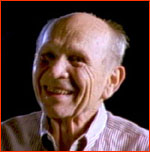
|
 |
 |
In 1958, Maxime A. Faget joined the space task group in NASA, forerunner of the NASA Manned Spacecraft Center that became the Johnson Space Center, and he became its assistant director for engineering and development in 1962 and later its director. He contributed many of the original design concepts for Project Mercury's manned spacecraft and played a major role in designing virtually every U.S. crewed spacecraft since that time, including the Space Shuttle. On NASA before Kennedy's speech about going to the moon before the end of the decade: "We were thinking about it. We were thinking about a rather comfortable program, if you want to put it that way." Well, we had thought about going to the moon before Kennedy said so, and as a matter of fact, Kennedy talked to NASA and said, Do you have any plans to go to the moon? And that answer was yes. We were thinking about it. We were thinking about a rather comfortable program, if you want to put it that way. We were not planning to land on the moon as a first part of the lunar program. We were planning to send men so that they could orbit the moon. First, they would just fly by and then shortly after that we would orbit the moon, and then we'd make some decisions on whether we'd land on the moon. And we expected to land on the moon sooner or later, because it was so close, and because everybody could see the moon and it made a very good target for the next program after Mercury. Now mind you, in those days we were just beginning on Mercury. We had just started that one and we had to get that one behind us before we went any further. But I might say, as Mercury developed, our plans became more and more ambitious. By the time that Kennedy said—which was after our first launch in Mercury, the sub-orbital flight that Shepard made - well, after that was when Kennedy made the announcement, and then we had a pretty good idea of making the landing and things like that, but they were not worked out in detail, they were just rough plans on how to do that sort of thing. And I might mention a lot of our thinking changed as we got into the details of the engineering. On the Russian space program: "Now, when NASA got into cooperative programs with the Russians, I was truly amazed at the sophistication, particularly their mechanical engineers—they were very good."
On what to bring to the moon: "Shoemaker, for instance, thought we ought to only carry black and white film."
On why a space vehicle should not be aerodynamic: "Now when you have a blunt face like that you create a huge shockwave, and all the drag is related to the shockwave and all the heat goes into the shockwave."
Back to Hear the Space Pioneers Photo: NASA Explore the Moon | Lunar Puzzlers | Last Man on the Moon Hear the Space Pioneers | Origins | Resources Transcript | Site Map | To the Moon Home Editor's Picks | Previous Sites | Join Us/E-mail | TV/Web Schedule About NOVA | Teachers | Site Map | Shop | Jobs | Search | To print PBS Online | NOVA Online | WGBH © | Updated November 2000 |
 Max Faget
Max Faget